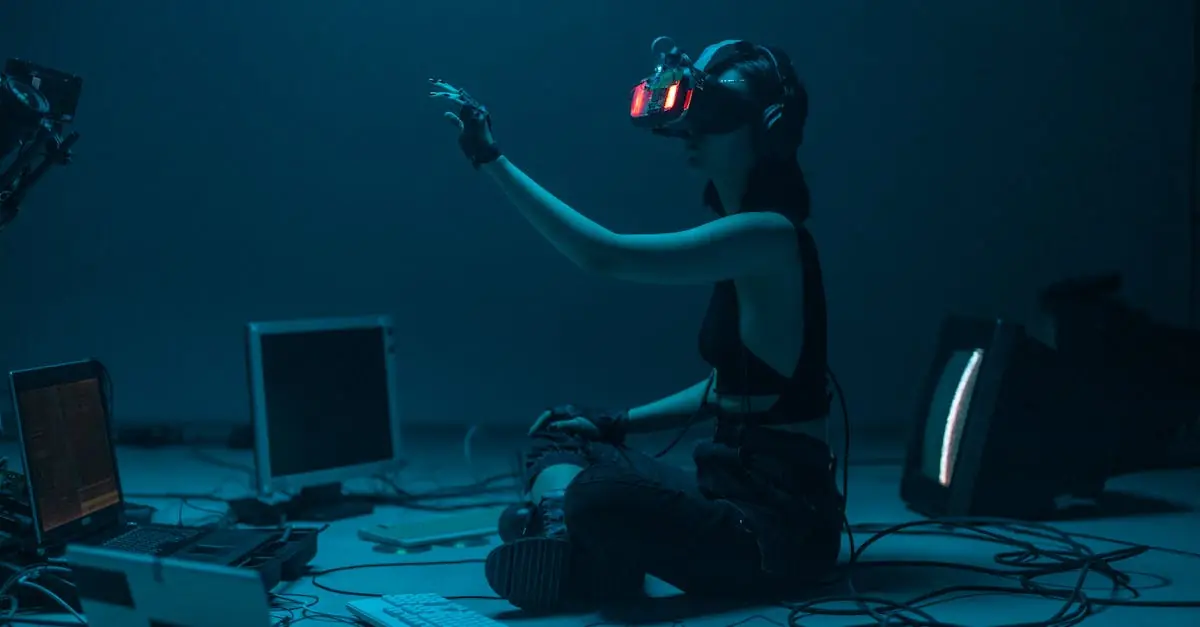Virtual reality has transformed how people experience digital worlds, but there’s a sneaky villain lurking in the shadows: latency. Imagine donning your VR headset only to find that your movements lag behind reality like a sloth on a Sunday stroll. Not exactly the immersive experience you signed up for, right?
Table of Contents
ToggleOverview of VR Latency Issues
VR latency issues significantly affect user experiences by introducing delays that disrupt immersion. Users expect immediate responsiveness when moving their heads or controllers. A lag of even 20 milliseconds can create noticeable discrepancies between real-world movements and virtual reactions.
Latency issues arise from various components, including hardware, software, and network connections. High latency in hardware can lead to delays in rendering images, making virtual environments feel sluggish. Software inefficiencies often cause frame drops, contributing to a disjointed experience. Network latency impacts online multiplayer VR scenarios, where split-second timing is crucial for interaction and gameplay.
Metrics like Motion-to-Photon (MTP) and Round Trip Time (RTT) provide insight into latency. MTP measures the delay from a user’s actions to visual feedback on the screen. RTT gauges the time it takes for data to travel to a server and back, essential for cloud-based VR applications.
Reducing latency involves optimizing equipment and refining user settings. Upgrade suggestions include installing faster graphics cards and ensuring high-quality VR headsets. Adjusting settings to lower the quality of graphics can also improve responsiveness, although at the cost of visual fidelity.
Content creators and developers can minimize latency through efficient coding and optimization techniques. Game design must prioritize environment complexity balanced with performance. Continuous testing in various network conditions helps identify and address latency problems early in the development process.
VR experiences rely heavily on the seamless integration of real-world and virtual elements, making latency management critical for satisfaction.
Causes of VR Latency Issues
VR latency issues stem from several key components that impact the overall experience. Understanding these causes helps in addressing and minimizing latency.
Hardware Limitations
Hardware limitations significantly contribute to VR latency. Graphics Processing Units (GPUs) play a crucial role; lower-end models struggle to process graphics quickly. In addition, slower refresh rates in displays can create delays. Insufficient processing power leads to lag, making the experience less immersive. Adopting high-performance hardware enhances the overall responsiveness. Upgrading to the latest GPUs can reduce delays. Most experts recommend hardware that supports a refresh rate of at least 90 Hz for optimal performance.
Software Optimization
Software optimization is essential to mitigate latency in VR. Code efficiency directly impacts performance; bloated or poorly optimized code can introduce unnecessary delays. Game engines must support real-time processing to ensure smooth interactions. Testing and refining algorithms is crucial; developers often prioritize frame rates to achieve seamless experiences. Regular software updates also enhance stability and performance. Implementing adaptive quality settings can dynamically adjust the experience based on hardware capabilities. Finally, optimizing network conditions leads to reduced latency for online VR applications.
Effects of VR Latency Issues on User Experience
VR latency issues significantly affect user experience. Even slight delays disrupt interactions and can lead to diminished satisfaction levels.
Motion Sickness
Motion sickness frequently occurs in VR environments due to latency problems. Discrepancies between physical movement and virtual response create discomfort for users. Symptoms may include dizziness, nausea, and disorientation. Controllers with input lag can intensify these issues, making it vital to minimize response times. Implementing hardware capable of lower latency, as found in high-end GPUs, reduces the chance of motion sickness. Developers can optimize software to enhance real-time processing and ensure smoother experiences. Users will enjoy more immersive environments when latency is kept to a minimum.
Reduced Immersion
Reduced immersion is another direct consequence of VR latency issues. Users lose the feeling of being present in the virtual world when delays occur. Real-time reactions to movement are crucial for a fully immersive experience. A latency of just 20 milliseconds can make actions feel unresponsive. Interaction with virtual environments becomes frustrating rather than engaging. High-performance hardware and optimized coding play significant roles in enhancing user immersion. Developers who prioritize continuous testing and software updates contribute to a more seamless experience. Ensuring low latency is essential for achieving the captivating experiences that users expect in VR.
Solutions to Mitigate VR Latency Issues
Addressing VR latency involves a combination of hardware upgrades and software optimizations. Both steps are essential for enhancing the overall user experience.
Upgrading Hardware
Upgrading hardware significantly improves VR performance. High-end Graphics Processing Units (GPUs) boost frame rates, ensuring smoother visuals. Switching to GPUs that support refresh rates of at least 90 Hz makes a noticeable difference in reducing latency. Enhanced processors also contribute to faster computations, lowering delays. Combining these upgrades with better display technologies, such as OLED or high-refresh-rate LCDs, elevates immersion levels. Hardware improvements should focus on those components that directly impact latency, thereby guaranteeing an optimized VR experience.
Optimizing Software
Optimizing software plays a crucial role in minimizing latency. Developers need to prioritize efficient coding practices. Utilizing real-time processing enables quicker responses to user inputs, reducing delays significantly. Additionally, implementing regular software updates helps address performance issues and adapt to new technologies. Adaptive quality settings allow the system to adjust graphics based on current hardware capabilities, further enhancing fluidity. An emphasis on optimization not only reduces lag but also improves the overall engagement in VR environments.
Addressing VR latency issues is essential for delivering a truly immersive experience. By focusing on both hardware and software improvements, users and developers can significantly enhance performance. Upgrading to high-quality GPUs and optimizing code are vital steps in minimizing delays.
Moreover, understanding the metrics that measure latency helps in identifying problem areas. As the VR landscape continues to evolve, prioritizing seamless interactions will not only reduce frustration but also elevate user satisfaction. Embracing these strategies ensures that the virtual worlds remain engaging and responsive, ultimately transforming how individuals connect with technology.

